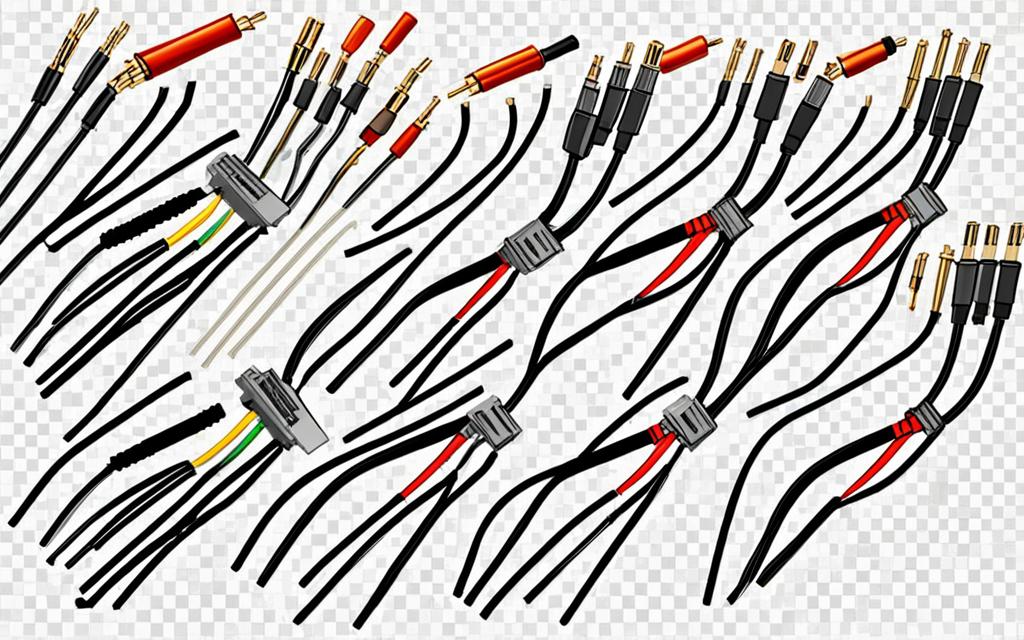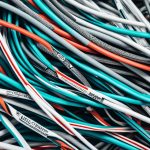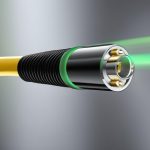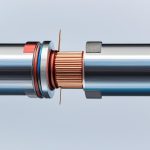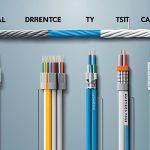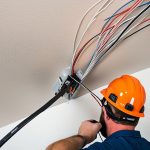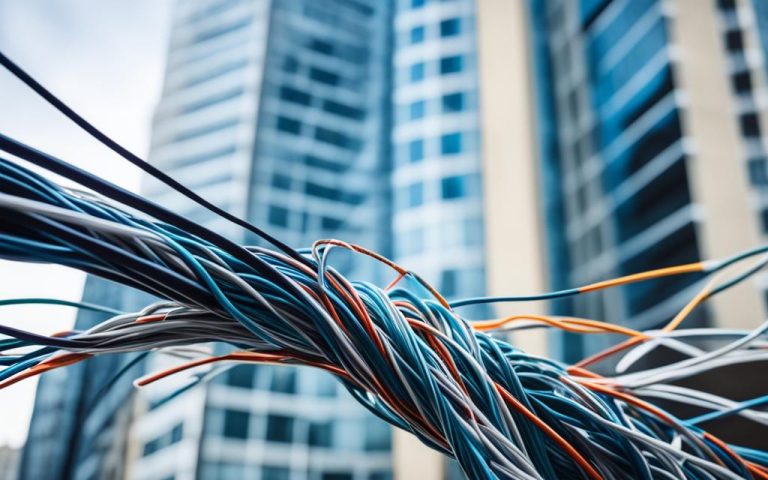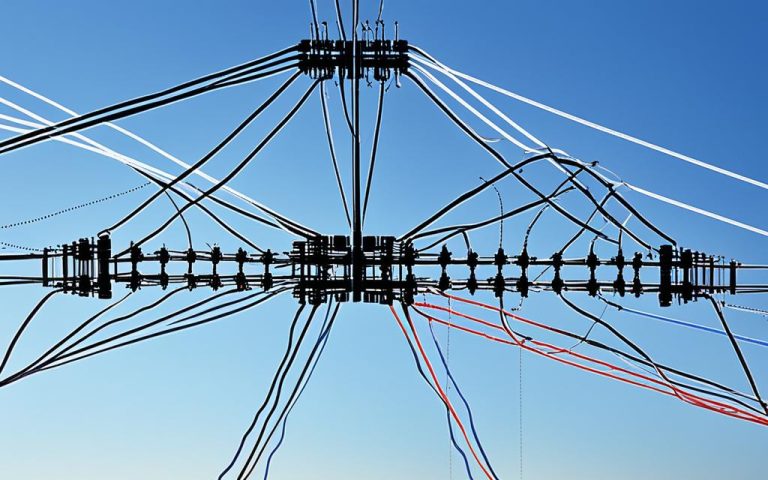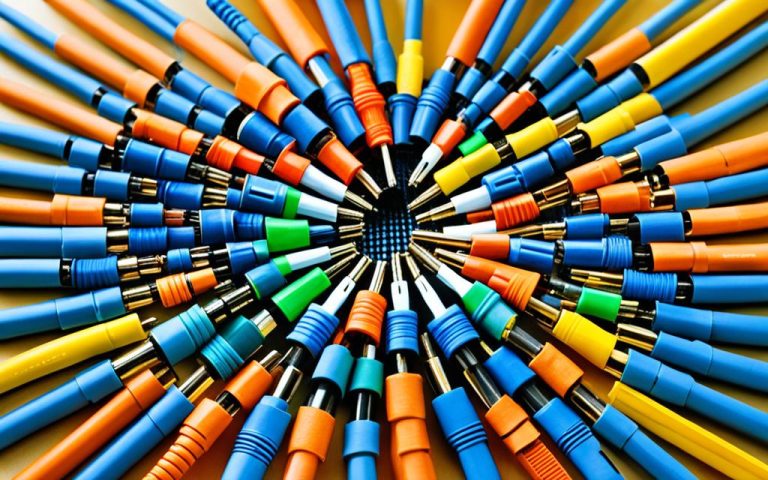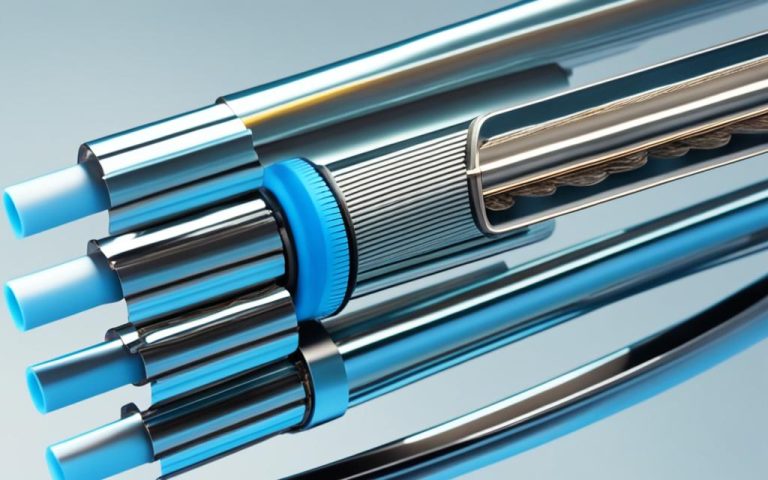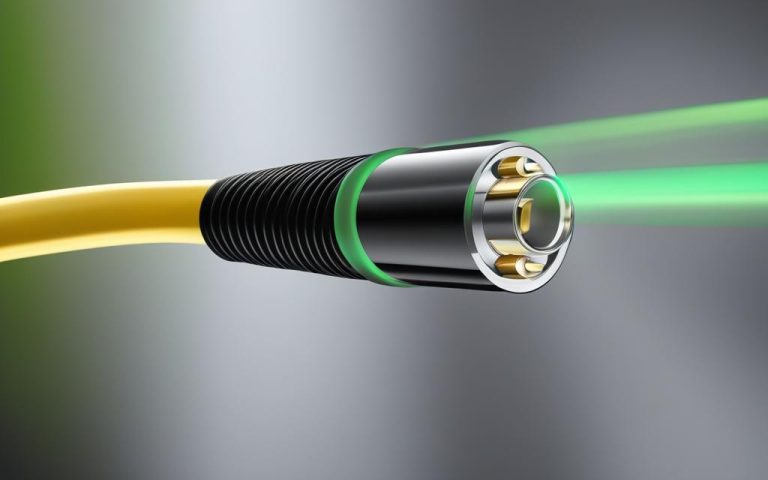Welcome to our article on coaxial cable networks. In today’s digital age, reliable and efficient communication is essential for various industries. Coaxial cable networks play a crucial role in ensuring the transmission of high-quality signals for video, data, and wireless communications.
There are two main types of coaxial cables used in these networks, each with its own set of characteristics and applications. Coaxial cables with an impedance of 75 Ohm (Ω) are primarily used for video signals, providing clear and sharp images for television broadcasts and video streaming. On the other hand, cables with an impedance of 50 Ohm are commonly utilized for data and wireless communications, facilitating fast and reliable transmission of information.
As technology continues to advance, the demand for high-speed data transfer and seamless wireless connectivity grows. Coaxial cables offer several advantages that make them an ideal choice for these applications. With a transfer capacity of 10Mb, coaxial cables can support large amounts of data, ensuring smooth and uninterrupted communication. Moreover, these cables are scalable, allowing for future expansion of networks as the need arises.
Another key advantage of coaxial cables is their durability and resistance to electromagnetic interference. These cables are designed to withstand various environmental conditions, ensuring a stable and reliable signal transmission. Additionally, coaxial cables are easy to install and cost-effective, making them a practical choice for both residential and commercial applications.
In the upcoming sections of this article, we will explore different types of coaxial cables, their applications, connectors, and how to choose the right cable setup for specific needs. So, let’s dive in and discover more about the world of coaxial cable networks!
Types of Coaxial Cables: RG-6, RG-59, RG-11
RF coaxial cables are essential for carrying radio frequency signals in various applications. Among the commonly used types of coaxial cables are RG-6, RG-59, and RG-11. Each type has its own specifications and is suited for specific signal transmission needs.
RG-6 Cable
RG-6 cables are known for their larger conductors, which contribute to better signal quality. They are commonly used for video and audio transmission, making them suitable for applications such as cable television, satellite TV, and high-definition video connectivity. The larger conductor size of RG-6 cables ensures reduced signal loss and improved overall performance. These cables are widely utilized in professional installations and home theater setups.
RG-59 Cable
RG-59 cables are thinner compared to RG-6 cables and are suitable for short runs and low-frequency transmissions. They are commonly used for CCTV systems, security cameras, and some video transmission applications. RG-59 cables offer decent signal quality for applications that do not require long-distance transmission.
RG-11 Cable
RG-11 cables are thicker and provide optimal signal transmission over longer distances. These cables offer lower attenuation and are suitable for high-bandwidth Broadband coaxial networks . RG-11 cables are commonly used for long-distance data transmission, such as in large-scale networks or commercial installations. Their thicker conductor size helps minimize signal loss and maintain signal integrity.
| Coaxial Cable Type | Conductor Size | Applications |
|---|---|---|
| RG-6 | Larger | Video and audio transmission, cable television, satellite TV |
| RG-59 | Thinner | CCTV systems, security cameras, some video transmission applications |
| RG-11 | Thicker | Long-distance data transmission, high-bandwidth applications |
Advantages of Coaxial Cables
Coaxial cables offer numerous advantages that make them a preferred choice for various applications. These cables have a transfer capacity of 10Mb, enabling high-speed data transmission. This capability makes them ideal for handling large data volumes efficiently.
Moreover, coaxial cables are highly scalable, allowing for future network expansions without experiencing significant disruptions or signal loss. As technology advances and network requirements grow, coaxial cables can easily accommodate these changes, making them a flexible solution.
Another notable advantage of coaxial cables is their durability. These cables are built to withstand harsh environmental conditions, ensuring reliable performance and longevity. They can resist physical stress and temperature variations, making them suitable for both indoor and outdoor installations.
Additionally, coaxial cables possess excellent resistance to electromagnetic interference (EMI). This characteristic prevents signal degradation and ensures a consistently stable connection. By effectively blocking EMI, coaxial cables provide a robust and reliable transmission pathway for various signals.
Moreover, the installation process of coaxial cables is straightforward and hassle-free. Their standardized connectors simplify the setup, saving time and effort. This ease of installation is particularly advantageous for both professional installers and DIY enthusiasts.
Furthermore, coaxial cables offer a cost-effective solution for many communication needs. Their affordability makes them a practical choice across different industries and applications, from residential setups to complex network infrastructures.
Overall, the advantages of coaxial cables make them a trusted and widely used option for signal transmission. From their high transfer capacity and scalability to their durability and resistance to electromagnetic interference, these cables provide a reliable and efficient solution for various communication needs.
| Advantages of Coaxial Cables | Description |
|---|---|
| High transfer capacity | Coaxial cables have a transfer capacity of 10Mb, enabling high-speed data transmission. |
| Scalability | These cables can accommodate future network expansions without significant disruptions or signal loss. |
| Durability | Coaxial cables are built to withstand harsh weather conditions, ensuring reliable performance and longevity. |
| Resistance to electromagnetic interference (EMI) | Coaxial cables effectively block EMI, providing a stable connection with minimal signal degradation. |
| Easy installation | The standardized connectors of coaxial cables simplify the installation process. |
| Cost-effectiveness | Coaxial cables offer a practical and affordable solution for various communication needs. |
Applications of Coaxial Cables
Coaxial cables have various applications in different industries and technologies. Their unique design and characteristics make them ideal for transmitting various types of signals. Here are some key applications where coaxial cables are commonly used:
1. Video Transmission
Coaxial cables are extensively used for video transmission, connecting televisions to antennas or satellite hardware. The high-quality signal transmission capability of coaxial cables ensures excellent image and sound quality for an enhanced viewing experience.
2. Internet Networking Cables
In the field of networking, coaxial cables are used for establishing wired connections between devices in local area networks (LANs). They are commonly used for connecting computers, routers, and other networking equipment, providing reliable and high-speed internet connectivity.
3. Cable Television Signals
Coaxial cables play a vital role in cable television systems, ensuring the delivery of multiple channels to households. These cables transmit television signals from the central distribution hub to individual homes, offering a wide range of programming options for viewers. The evolution of cable TV networks, from analog to digital broadcasting, has been significantly supported by the advancements in coaxial cable technology. This evolution has enabled higher quality audio and visual content, on-demand services, and internet access through the same coaxial cable infrastructure, marking a pivotal shift in how entertainment and information are delivered to consumers. Coaxial cables continue to be a cornerstone in connecting the modern world, demonstrating their versatility and reliability in various telecommunications applications, including CATV networks.
4. Radio Transmitters and Receivers
Coaxial cables are also utilized in radio communication systems for transmitting and receiving signals. They provide a direct and efficient means of transferring radio frequency signals between antennas, transmitters, amplifiers, and receivers. The ability of coaxial cables to withstand electromagnetic interference makes them reliable for such applications.
To visualize the various applications of coaxial cables, refer to the following interactive table:
| Application | Description |
|---|---|
| Video Transmission | Connecting televisions to antennas or satellite hardware |
| Internet Networking Cables | Establishing wired connections in LANs |
| Cable Television Signals | Transmitting television signals from distribution hubs to households |
| Radio Transmitters and Receivers | Transmitting and receiving radio frequency signals |
In addition to these applications, coaxial cables find use in various other fields where reliable and efficient signal transmission is essential.
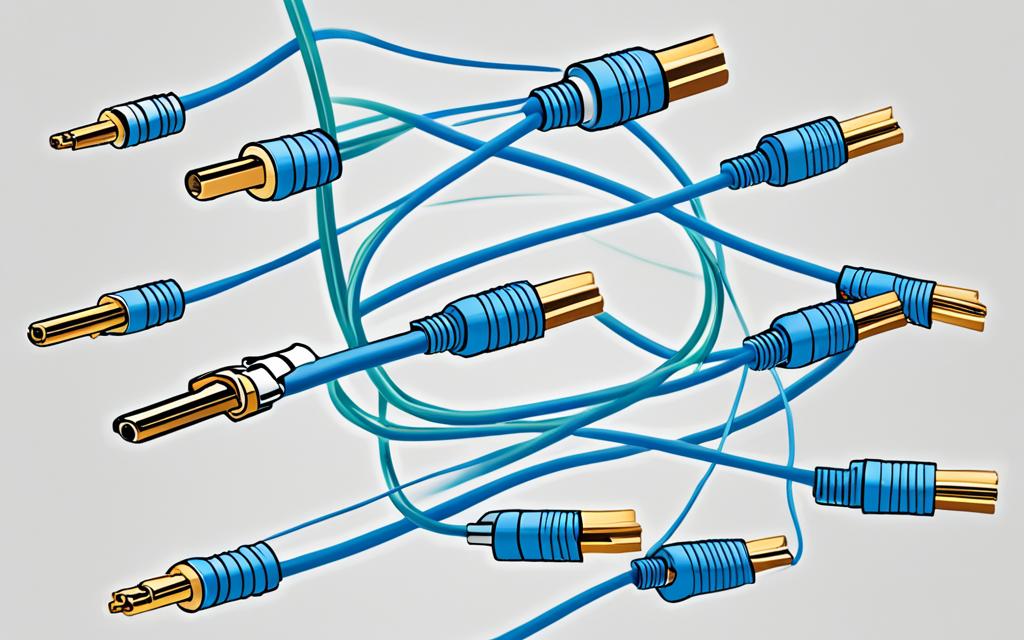
Coaxial cables are versatile and highly reliable, making them a preferred choice in the world of telecommunications. Whether it’s transmitting high-quality videos, establishing internet connections, delivering cable television signals, or enabling radio communication, coaxial cables continue to play a significant role in connecting the modern world.
Types of Coaxial Cables: RG59, RG6, RG11
When it comes to coaxial cables, there are three common types that are widely used in various applications. These types are RG59, RG6, and RG11. Each type has its own unique design and features, making them suitable for different purposes.
RG59 Cable
The RG59 cable is known for its flexibility, rigid shielding, and thick insulation. Due to its design, RG59 cables are commonly used for connecting satellite boxes and TVs, as well as for CCTV setups. The flexibility of RG59 cables allows for easy installation and routing, while the rigid shielding provides excellent protection against electromagnetic interference. Additionally, the thick insulation ensures optimal signal transmission and minimizes signal loss.
RG6 Cable
RG6 cables are designed with higher quality shielding and thicker insulation compared to RG59 cables. These features make RG6 cables suitable for outdoor conditions and long-distance signal transmission. The higher quality shielding provides better protection against interference from external sources, ensuring a stable and clear signal. With its improved insulation, RG6 cables offer superior signal quality over longer distances, making them ideal for installations that require a reliable and strong signal.
RG11 Cable
Among the three types, RG11 cables are the thickest and offer the highest performance. These cables are designed to transmit signals over longer distances without degradation. With their superior insulation, RG11 cables minimize signal loss and provide excellent shielding against external interference. This makes them particularly suitable for applications that require signal transmission over extended distances, such as large-scale networks or commercial installations.
Choosing the right type of coaxial cable is essential to ensure optimal signal quality and performance for your specific needs. Whether you require flexibility, outdoor durability, or long-distance transmission capabilities, understanding the design and features of RG59, RG6, and RG11 cables can help you make an informed decision.
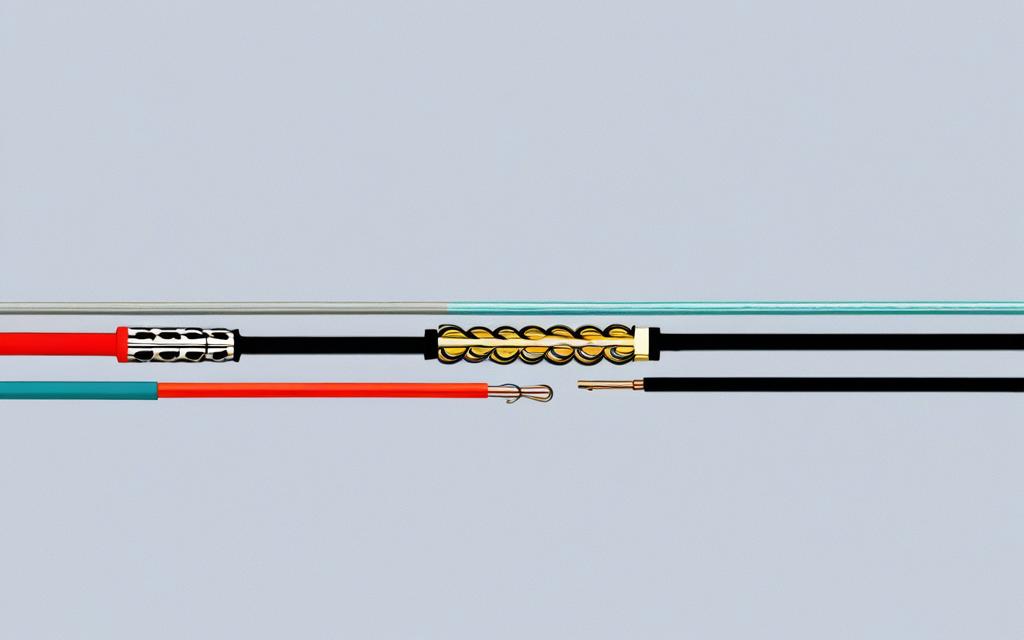
| Cable Type | Design | Flexibility | Shielding | Insulation |
|---|---|---|---|---|
| RG59 | Flexible | Rigid | Excellent protection against electromagnetic interference | Thick insulation for optimal signal transmission |
| RG6 | Thicker shielding and insulation | Less flexible than RG59 | Superior protection against external interference | Improved signal quality over longer distances |
| RG11 | Thickest design | Less flexible than RG6 | Superior shielding against external interference | Minimizes signal loss over extended distances |
Coaxial Cable Connectors
Coaxial cable connectors play a crucial role in connecting cables to various devices, ensuring a secure and reliable connection. Different connector types are available, each offering its own advantages and suitability for specific applications. Here are the common coaxial cable connectors:
BNC Connectors
BNC connectors, short for Bayonet Neill-Concelman, are widely used in audio and video transmission systems. They are easy to connect and disconnect, making them ideal for applications that require frequent cable swapping. BNC connectors have a bayonet-style coupling mechanism, ensuring a secure and reliable connection. They are commonly used in video surveillance systems, oscilloscopes, and radio frequency applications.
TNC Connectors
TNC connectors, standing for Threaded Neill-Concelman, are similar to BNC connectors in functionality but have a threaded coupling mechanism instead. This ensures a more secure connection, making TNC connectors suitable for applications that involve vibration or movement. They are commonly used in wireless communication systems, industrial equipment, and military applications.
SMA Connectors
SMA connectors, or SubMiniature version A connectors, are designed for applications that require high-frequency signals. These connectors offer excellent electrical performance and are widely used in wireless communication systems, satellite communication, and test and measurement equipment. SMA connectors have a thread-in coupling mechanism, ensuring a secure connection.
SMB Connectors
SMB connectors, or SubMiniature version B connectors, are smaller in size compared to SMA connectors. They are commonly used in applications that require compactness and high-frequency signals, such as GPS systems, automotive electronics, and telecommunications equipment. SMB connectors feature a snap-on coupling mechanism, providing quick and reliable connections.
QMA Connectors
QMA connectors, or Quick-locking Multi-coaxial connectors, offer the convenience of quick and easy installation. They have a push-lock coupling mechanism, eliminating the need for threading and providing a secure connection. QMA connectors are commonly used in wireless communication systems, WLAN networks, and test and measurement equipment.
7/16 DIN Connectors
7/16 DIN connectors are robust and reliable connectors designed for high-power applications. They have a threaded coupling mechanism, ensuring a secure and stable connection in demanding environments. 7/16 DIN connectors are commonly used in cellular base stations, broadcast systems, and high-power RF applications.
MCX Connectors
MCX connectors, or Micro Coaxial connectors, are compact and lightweight connectors suitable for applications that require space-saving designs. They are commonly used in consumer electronics, GPS systems, and wireless communication devices. MCX connectors have a snap-on coupling mechanism, providing quick and reliable connections.
F-type Connectors
F-type connectors are widely used in television equipment and cable TV distribution systems. They have a screw-on coupling mechanism, ensuring a secure and stable connection. F-type connectors are commonly used for coaxial cables used in cable TV connections, satellite TV installations, and cable modems.
Choosing the right coaxial cable connector depends on the specific application requirements. Consider factors such as frequency range, ease of installation, and environmental conditions to ensure optimal performance and reliability.
| Connector Type | Advantages | Applications |
|---|---|---|
| BNC | Easy to connect and disconnect | Audio/video transmission, video surveillance systems |
| TNC | Threaded coupling for secure connection | Wireless communication systems, industrial equipment |
| SMA | High-frequency performance | Wireless communication, satellite communication |
| SMB | Compact size, quick snap-on connection | GPS systems, automotive electronics |
| QMA | Quick-locking, easy installation | Wireless communication systems, WLAN networks |
| 7/16 DIN | Robust design, high-power applications | Cellular base stations, broadcast systems |
| MCX | Compact and lightweight | Consumer electronics, GPS systems |
| F-type | Screw-on coupling, commonly used for TV equipment | Cable TV connections, satellite TV installations |
Choosing the Right Coaxial Cables
When selecting the appropriate coaxial cables for your application, it is crucial to consider the specific requirements and needs. The two commonly used cable types, RG6 and RG11, offer distinct advantages depending on the use case.
RG6 cables are ideally suited for high-definition TVs, providing excellent signal quality for video transmission. Their larger conductors ensure better performance and enable seamless delivery of crisp, clear images and sound.
On the other hand, RG11 cables excel in long-distance transmission scenarios. With their thicker construction and lower attenuation, these cables minimize signal degradation over extended distances, making them ideal for applications such as commercial installations, large-scale networking, and data transmission.
Equally important to the selection of the right cable type is the choice of connectors. Proper connectors guarantee reliable connections and optimal performance. Below are some commonly used coaxial cable connectors:
- BNC: Known for their ease of installation, BNC connectors are widely used in audio and video transmission systems. They provide a secure connection and are commonly found in surveillance systems and video production setups.
- F-type: These screw-on connectors are commonly used for television connections. They are easy to install and provide a reliable connection for cable television signals and other applications.
By understanding the specific needs of your application and considering factors such as cable type and connector compatibility, you can ensure a reliable and efficient coaxial cable setup.
Conclusion
Coaxial cable networks play a critical role in ensuring efficient telecommunication infrastructure and maintaining signal quality. By understanding the various types of coaxial cables, their applications, and the different connectors available, individuals and businesses can make informed decisions when setting up their networks.
When it comes to video and data transmission, RG6 and RG11 cables are widely used and considered reliable options. RG6 cables are commonly utilized for high-definition television systems, while RG11 cables are preferred for long-distance data transmission.
In addition to selecting the appropriate cable type, utilizing the right connectors is equally essential. Connector options such as BNC and F-type offer distinct advantages for connecting coaxial cables to various devices. BNC connectors, for instance, are popular due to their ease of use and frequent application in audio and video transmission systems. On the other hand, F-type connectors, known for their screw-on design, are commonly used with television equipment.
By bringing together the right coaxial cable type and suitable connectors, individuals and businesses can create robust and efficient coaxial cable networks that meet their specific requirements. Whether it’s for video transmission, internet networking, cable television signals, or radio transmitters and receivers, coaxial cables prove their worth by providing reliable signal transmission, high durability, and resistance to electromagnetic interference.
FAQ
What are the different types of coaxial cables used in coaxial cable networks?
The two main types of coaxial cables used in coaxial cable networks are those with an impedance of 75 Ohm (Ω) and those with an impedance of 50 Ohm. Cables with 75 Ohm impedance are primarily used for video signals, while cables with 50 Ohm impedance are commonly used for data and wireless communications.
Which are the most commonly used types of coaxial cables?
The most commonly used types of coaxial cables are RG-6, RG-59, and RG-11. RG-6 cables have larger conductors, providing better signal quality and are commonly used for video and audio transmission. RG-59 cables are thinner and suitable for short runs and low-frequency transmissions. RG-11 cables are thicker and offer lower attenuation, making them ideal for longer distance data transmission.
What are the advantages of using coaxial cables?
Coaxial cables have several advantages. They have a transfer capacity of 10Mb, making them suitable for high-speed data transmission. They are also scalable, allowing for future expansion of networks. Coaxial cables are durable and resistant to electromagnetic interference, ensuring a reliable signal transmission. Additionally, they are easy to install and cost-effective.
What are the applications of coaxial cables?
Coaxial cables have various applications. They are commonly used for video transmission, connecting televisions to antennas or satellite hardware. They are also used for internet networking cables, cable television signals, and connecting radio transmitters and receivers. The ability of coaxial cables to withstand electromagnetic interference makes them ideal for these applications.
What are the characteristics of RG59, RG6, and RG11 coaxial cables?
RG59 coaxial cables are flexible, have rigid shielding, and thick insulation. They are commonly used for connecting satellite boxes and TVs, as well as for CCTV setups. RG6 cables have higher quality shielding and thicker insulation, making them suitable for outdoor conditions and better signal quality over long distances. RG11 cables are the thickest and can transmit signals over longer distances without degradation.
What are the different types of coaxial cable connectors?
Coaxial cable connectors come in various types, including BNC, TNC, SMA, SMB, QMA, 7/16 DIN, MCX, and F-type. Each connector has its own advantages and is suitable for different applications. For example, BNC connectors are easy to connect and are commonly used in audio or video transmission systems. F-type connectors are screw-on connectors used for television equipment.
How do I choose the right coaxial cables for my needs?
When choosing coaxial cables, it is important to consider the specific needs of the application. RG6 cables are suitable for high-definition TVs, while RG11 cables are better for long-distance transmission. It is also essential to choose the right connectors for the specific cable type and application to ensure reliable connections.
What are the key takeaways about coaxial cable networks, types, applications, and connectors?
Coaxial cable networks are crucial for telecommunication infrastructure and signal quality. Understanding the different types of coaxial cables, their applications, and connectors can help in choosing the right setup for specific needs. RG6 and RG11 cables are commonly used for video and data transmission, while various connectors such as BNC and F-type offer different advantages for connecting cables to devices.

